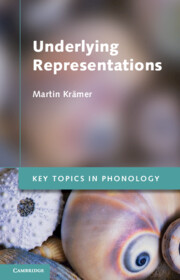Book contents
- Frontmatter
- Contents
- Acknowledgements
- Abbreviations
- 1 Getting started
- 2 Arbitrariness and opposition
- 3 Derivation and abstractness
- 4 Underspecification returns
- 5 The devil is in the detail
- 6 Psycho- and neurolinguistic evidence
- 7 On the form and contents of contrastive features
- 8 Underlying representations in Optimality Theory
- 9 Preliminary results
- Glossary
- Notes
- References
- Name index
- Language index
- Subject index
- References
9 - Preliminary results
Published online by Cambridge University Press: 05 November 2012
- Frontmatter
- Contents
- Acknowledgements
- Abbreviations
- 1 Getting started
- 2 Arbitrariness and opposition
- 3 Derivation and abstractness
- 4 Underspecification returns
- 5 The devil is in the detail
- 6 Psycho- and neurolinguistic evidence
- 7 On the form and contents of contrastive features
- 8 Underlying representations in Optimality Theory
- 9 Preliminary results
- Glossary
- Notes
- References
- Name index
- Language index
- Subject index
- References
Summary
There is some correct answer to the question of how lexical items are represented[.]
(Chomsky & Halle 1968: 296)IN SEARCH OF THE HOLY GRAIL?
At the end of this book it is time to take stock of what we know about underlying representations. The first and most fundamental question, after looking at all these studies and arguments, is of course the same one we can ask about the holy grail alluded to in the quote by Labov at the beginning of Chapter 1. Do underlying representations exist?
One might counter that this is a stupid question, since to be competent speakers of a language we have to have memorized linguistic units in one way or another in our minds. However, the question is more about whether they exist as specifically linguistic entities and not as memories as in general cognition, such as the memory of eating pizza at the Italian restaurant around the corner three weeks ago or the memory of pizza as such (as differentiated from kebab or pine trees or our mental representation of having a headache).
The answer is: both. We have seen language-internal as well as external evidence for categorization and abstract features, but we have also seen that statistics of linguistic experience and phonetic detail play a role in the shaping of phonological patterns and thus have to be present in the minds of speakers in some form.
- Type
- Chapter
- Information
- Underlying Representations , pp. 212 - 221Publisher: Cambridge University PressPrint publication year: 2012
References
- 1
- Cited by

